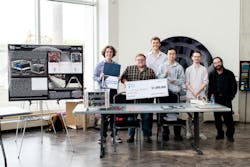NASA names pair of 'Watts on the Moon Challenge' awardees
CLEVELAND - The National Aeronautics and Space Administration (NASA) announced it has awarded $1.5 million to two U.S. teams for developing innovative energy distribution, management, and storage solutions as part of the agency’s Watts on the Moon Challenge.
These technologies are designed to support the Artemis missions, which aim to establish a long-term human presence on the Moon.
The competition, which spanned two phases, tasked U.S. teams with creating advanced power transmission and energy storage systems for extended lunar missions. The final phase concluded with a technology showcase and awards ceremony at the Great Lakes Science Center in Cleveland, home to the visitor center for NASA’s Glenn Research Center.
“Congratulations to the finalist teams for developing impactful power solutions in support of NASA’s goal to sustain human presence on the Moon,” said Kim Krome-Sieja, acting program manager for NASA Centennial Challenges at the agency’s Marshall Space Flight Center in Huntsville, Alabama. “These technologies seek to improve our ability to explore and make discoveries in space and could have implications for improving power systems on Earth.”
Related: NASA's Glenn Research Center seeks space flight systems
The winners are:
First prize ($1 million): H.E.L.P.S. (High-Efficiency Long-Range Power Solution) from Santa Barbara, California
Second prize ($500,000): Orbital Mining Corporation from Golden, Colorado
Four teams were invited to refine their hardware and deliver full system prototypes for testing at NASA Glenn. Three finalists completed their solutions, which were the first power transmission and energy storage prototypes tested in a vacuum chamber replicating the extreme conditions at the permanently shadowed regions of the Lunar South Pole. Teams had to demonstrate operability during six hours of solar daylight and 18 hours of darkness while being nearly two miles from the power source.
Related: NASA Glenn breaks ground on new aerospace communications facility
Judges evaluated the finalists’ solutions based on a Total Effective System Mass (TESM) calculation, measuring system performance relative to size and weight. The lowest TESM score indicated the most effective solution, reflecting the challenge of reducing mass while meeting the energy demands of space missions.
H.E.L.P.S. from the University of California, Santa Barbara, won the top prize for a lightweight, high-efficiency system. Their design featured a special cable operating at 800 volts and an energy storage system on both ends of the transmission. They also employed a variable radiation shield to regulate heat, depending on power demands. The system met all the power, storage, and thermal requirements during the final 48-hour test.
Orbital Mining Corporation, a space technology startup, earned second place with a high-performance system that also passed the 48-hour test. Their design included a high-voltage converter, a low-mass cable, and a lithium-ion battery.
Related: NASA taps Yank Technologies for power systems on Moon, Mars
“The energy solutions developed by the challenge teams are poised to address NASA’s space technology priorities,” said Amy Kaminski, program executive for Prizes, Challenges, and Crowdsourcing at NASA Headquarters in Washington. “These solutions support NASA’s recently ranked civil space shortfalls, including in the top category of surviving and operating through the lunar night.”
